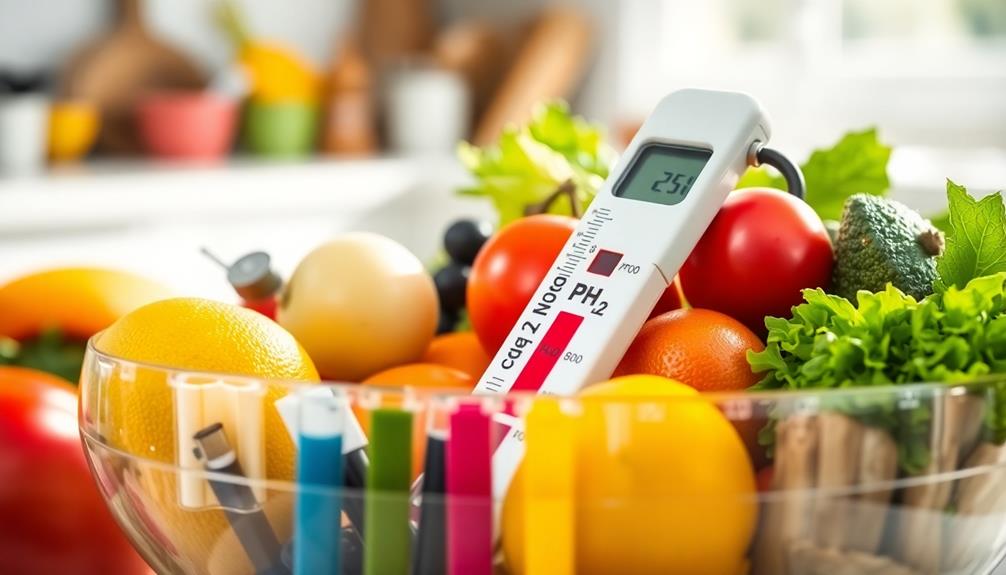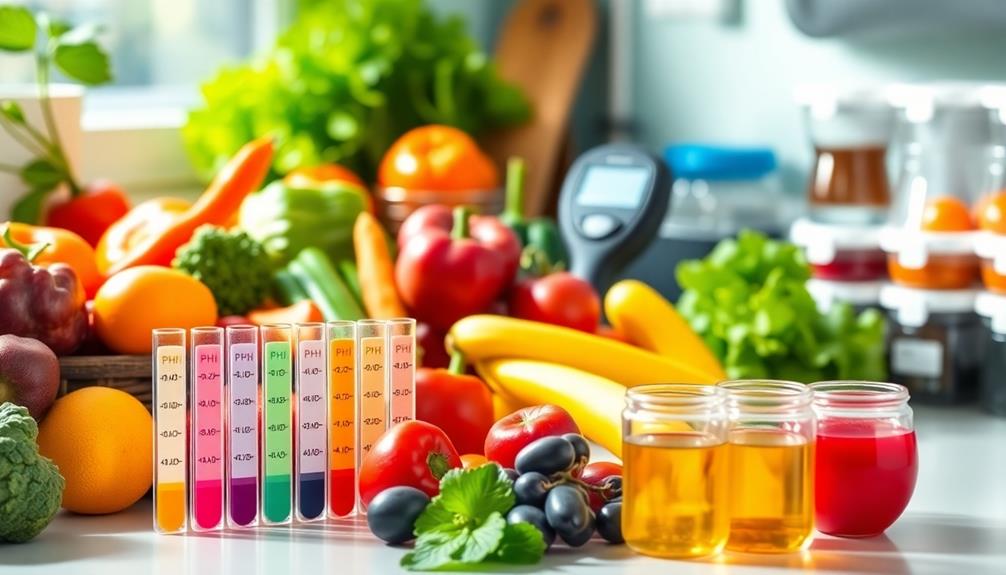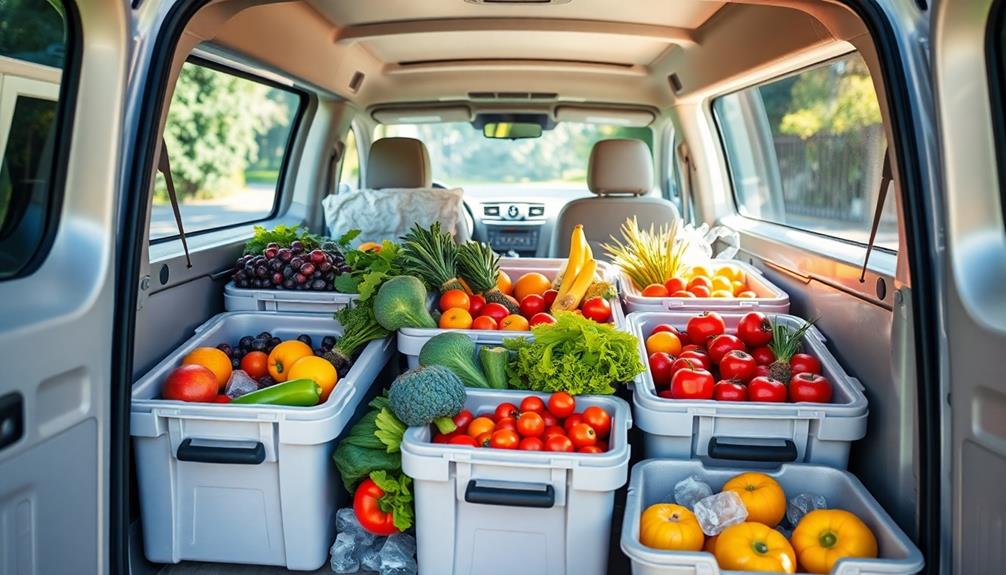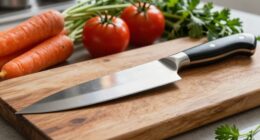Understanding pH in raw food safety is vital for preventing harmful bacteria growth. The pH scale ranges from 0 to 14, where values below 4.6 indicate high-acid foods that inhibit dangerous microorganisms. Maintaining proper pH not only preserves food quality but also extends shelf life. Regular monitoring is essential since fluctuations can lead to spoilage and foodborne illnesses. Compliance with safety standards guarantees your food remains safe for consumption. By mastering pH management, you bolster your skills for effective food preservation techniques. There's a lot more to explore about maximizing safety and quality in your raw food practices.
Key Takeaways
- pH measures acidity, affecting microbial growth and food safety, with high-acid foods having a pH of 4.6 or lower.
- Maintaining proper pH levels inhibits harmful bacteria like Clostridium botulinum, crucial for safe food preservation.
- Regular pH monitoring ensures compliance with food safety regulations and enhances product quality and shelf life.
- Accurate pH measurement techniques involve using calibrated meters and controlled conditions for reliable results.
- Understanding the differences between high-acid and low-acid foods guides safe canning practices and processing methods.
What Is Ph?

Understanding pH is fundamental for anyone interested in food safety, especially when dealing with raw foods. pH, or potential hydrogen, measures the concentration of hydrogen ions in a solution, ranging from 0 (most acidic) to 14 (most basic), with 7 being neutral.
The pH scale is logarithmic, which means that each whole number change represents a tenfold difference in acidity or alkalinity. For instance, a food with a pH of 3 is ten times more acidic than one with a pH of 4.
When measuring pH in food, you'll find that foods are classified based on their pH levels. High-acid foods have a pH of 4.6 or lower, while low-acid foods exceed that threshold. This classification is important because it impacts food safety and preservation methods.
The critical pH value of 4.6 plays a significant role in preventing harmful bacteria, such as Clostridium botulinum, from thriving in canned foods. As a result, accurate pH measurement isn't just about flavor and texture; it's about ensuring microbial safety.
Regular monitoring and adjustments in pH levels are fundamental for safe food production.
Importance of Ph in Food

Understanding pH is essential for maintaining food quality and safety.
It not only affects flavor and texture but also inhibits harmful microbial growth, ensuring your food stays safe to eat.
Plus, staying within regulatory pH guidelines helps you meet safety standards and keeps consumers confident in your products.
Ph and Food Quality
Maintaining the right pH in food is fundamental for guaranteeing its quality and safety. The pH value notably influences key attributes like flavor, color, and texture, which are essential for consumer acceptance.
Foods with a pH of 4.6 or lower are considered high-acid foods, effectively inhibiting the growth of harmful microorganisms, which enhances food safety. This is particularly important when it comes to Clostridium botulinum, a dangerous bacterium that can thrive in improperly canned foods.
To prevent botulism, it's critical to keep the pH at or below the pivotal level of 4.6. Ideally, maintaining a pH of 4.2 or lower in canned foods is fundamental for both safety and extending shelf life.
Regular pH monitoring during food processing is vital for compliance with safety regulations and guaranteeing your product maintains its quality throughout its lifecycle. By paying close attention to acidity or alkalinity, you can assure that your food not only stays safe for consumption but also meets the standards consumers expect.
Prioritizing the right pH helps you deliver high-quality food that customers can trust.
Microbial Growth Inhibition
How can pH levels considerably impact the safety of your food? Understanding pH is essential because it plays a significant role in inhibiting microbial growth. For instance, foods with a pH below 4.6 can effectively prevent the growth of harmful bacteria like Clostridium botulinum, especially in canned goods. On the other hand, most bacteria thrive in a neutral to mildly acidic pH range (around 6.5 to 7.5), making pH control important for food safety.
| pH Level Range | Microbial Activity |
|---|---|
| Below 4.6 | Inhibits Clostridium botulinum |
| 4.6 – 6.5 | Low-acid foods, some microbial growth |
| 6.5 – 7.5 | Ideal for bacteria |
| Above 7.5 | High risk for spoilage |
| Acidified Foods | Extended shelf life, reduced growth |
Regulatory Compliance Importance
Regulatory compliance in food production hinges on strict adherence to pH standards, which are fundamental for guaranteeing safety and quality. The FDA mandates specific pH values for different food categories, classifying high-acid foods as those with a pH of 4.6 or lower.
If you're producing low-acid foods, you must pressure cook them at temperatures of 240°F (115.6°C) or higher to eliminate the risk of botulism.
For acidified foods, it's imperative to register your formulas and processing methods with the FDA using form 2541. This step is essential for maintaining regulatory compliance and guaranteeing food safety.
Scheduled processes validated by a recognized Process Authority further confirm your products meet safety standards, particularly regarding pH levels.
Regular pH measurements and documentation are also crucial. Any deviations can lead to health hazards and disrupt your business, emphasizing the importance of staying compliant.
Ph Measurement Techniques

Accurate pH measurement is essential for guaranteeing the safety of raw foods, and there are several techniques to achieve reliable results. Start with a well-calibrated pH meter, using standard buffer solutions at pH 4.0 to guarantee accurate measurements.
Remember, temperature matters too; measure pH at a controlled temperature of 25°C, as fluctuations can skew your results.
When you're preparing samples, make sure to blend solid-liquid mixtures into a uniform paste. This consistency helps maintain a representative solid-to-liquid ratio, vital for reliable pH measurement.
If your sample lacks moisture, adding 10-20 mL of distilled water per 100 grams can help achieve a suitable consistency for testing.
To maintain the integrity of your readings, regularly rinse the pH probe with distilled water and blot it dry with soft tissue before use. This step minimizes contamination and enhances measurement accuracy.
Following these processing procedures can greatly impact your food safety assessments, guaranteeing that you're getting the most reliable pH readings for raw foods.
Ph and Food Safety

pH levels play a key role in food safety, influencing how well harmful bacteria can grow.
If you're working with low-acid foods, keeping that pH above 4.6 is essential to prevent issues like botulism.
Understanding the differences between acidified and low-acid foods can help you implement safe canning practices that protect your products.
Ph Levels and Microbial Growth
Microbial growth is heavily influenced by the acidity or alkalinity of food, with most bacteria thriving in a neutral to slightly acidic range between 6.5 and 7.5. Understanding the pH scale is essential for maintaining food safety.
For instance, Clostridium botulinum spores can germinate and produce toxins in low-acid environments where the pH is above 4.6. This poses serious health risks if low acid foods, like certain vegetables and meats, aren't processed correctly.
Yeasts and molds, on the other hand, can tolerate lower pH conditions than bacteria, making them common in acidic foods. However, if pH levels rise, these spoilage organisms can still thrive. That's why regular pH monitoring is critical.
Small fluctuations in pH can greatly impact microbial growth and food preservation. Foods with a pH below 4.6, such as pickles and jams, are classified as high-acid foods and are less likely to support harmful bacteria.
Acidified vs. Low-Acid Foods
Understanding the difference between acidified and low-acid foods is vital for securing safe food preservation. Acidified foods, like pickles and certain sauces, have had acids added to them, lowering their pH to 4.6 or below. This adjustment helps prevent microbial growth, making these foods safer for storage and consumption.
On the other hand, low-acid foods, which have a pH greater than 4.6, pose a significant risk because they can support the growth of harmful bacteria like Clostridium botulinum.
To eliminate this risk, low-acid foods require pressure canning, a method that guarantees the temperature is high enough to kill any potential pathogens. The important pH threshold of 4.6 is vital in food safety, as it dictates the preservation methods you need to use.
Both acidified and low-acid foods must be monitored and controlled for pH to comply with food safety regulations and prevent foodborne illnesses. By understanding these distinctions, you can make informed decisions about food preservation and enjoy your homemade creations safely.
Safe Canning Practices
When canning, it's crucial to follow safe practices to protect your food from harmful bacteria. Understanding the pH of the foods you're canning is important, especially when dealing with low-acid foods, which have a pH greater than 4.6.
These foods require pressure cooking at temperatures of 240°F or higher to eliminate the risk of Clostridium botulinum, a dangerous neurotoxin.
To guarantee food safety during canning, keep these practices in mind:
- Always measure pH accurately to prevent spoilage.
- Follow FDA regulations and register your canning processes.
- Utilize appropriate processing methods for each food type.
- Use hot water baths for high-acid foods, but pressure can for low-acid options.
- Maintain detailed records of your pH testing for traceability.
Regulatory Standards

Regulatory standards play an essential role in guaranteeing the safety of raw foods, particularly those that are acidified or classified as low-acid. For acidified foods, the FDA mandates that you register your formulas and processing methods using form 2541. This step is significant for maintaining regulatory compliance and guaranteeing safety and quality.
Foods classified as low-acid, with a pH range greater than 4.6, require pressure cooking at temperatures of 240°F (115.6°C) or higher to inhibit the growth of Clostridium botulinum. On the other hand, high-acid foods, with a pH of 4.6 or lower, can be safely processed using less intense methods like hot water baths or hot-filling techniques.
To meet these standards, facilities must keep important production records, including formulation details, processing times, and pH tests. These records not only aid in regulatory compliance but also facilitate safety audits.
Additionally, it's mandatory for personnel involved in producing acidified foods to undergo training at a Better Process Control School. This guarantees they understand the key safety protocols and processing requirements necessary for producing safe, quality food.
Effects of Ph on Microbial Growth

pH greatly impacts microbial growth, influencing food safety and preservation methods. You need to understand that different microorganisms have varying pH tolerances. Most bacteria thrive in neutral to slightly alkaline conditions, while yeasts and molds can survive in more acidic environments.
Here's why you should care:
- Deadly toxins from Clostridium botulinum can develop in low-acid foods if pH isn't monitored.
- Foodborne illnesses can arise from uncontrolled microbial growth.
- Spoilage can ruin your food and lead to waste.
- Food safety regulations require strict pH control for compliance.
- Preservation methods depend on understanding pH to guarantee the longevity of your food.
For instance, a pH below 4.6 is vital for inhibiting Clostridium botulinum, which is essential for safe processing of low-acid foods. Elevated pH levels can promote harmful microorganisms, making regular monitoring of pH necessary during food production.
Even slight changes in pH can dramatically affect microbial growth rates and overall food safety. Prioritizing pH management can make all the difference in guaranteeing that the food you prepare is safe to eat.
Best Practices for Ph Management

Effective pH management is essential for ensuring food safety and quality. To achieve accurate pH measurements, you should regularly calibrate your pH meters with standard buffers, ideally before each use. This practice helps maintain the reliability of your readings.
Additionally, always rinse your pH probes with distilled water and blot them dry to avoid contamination from previous samples.
When preparing food products for pH testing, maintain a consistent solid-to-liquid ratio. This consistency enhances the representativeness of your measurements, particularly for solid or viscous items.
If your sample lacks sufficient moisture, consider adding 10-20 mL of distilled water per 100 grams to achieve a uniform consistency for accurate testing.
Engaging in training programs like the Better Process Control School (BPCS) can greatly improve your knowledge and skills in effective pH management and safety practices.
By incorporating these best practices into your routine, you'll enhance the safety and quality of your food products, minimizing the risk of microbial growth and ensuring compliance with food safety standards.
Frequently Asked Questions
What Is the Role of Ph in Food Safety?
pH plays an essential role in food safety by inhibiting harmful microorganisms. When you maintain proper pH levels, you reduce spoilage risks and guarantee your food remains safe for consumption, protecting both your health and business.
What Ph Level Should Raw Meat Be?
Raw meat should generally have a pH level between 5.1 and 6.9, depending on the type. Ground beef averages around 5.5, while chicken's pH ranges from 6.5 to 6.7, indicating potential spoilage risks.
What Is a Safe Ph Level for Food?
Think of pH as a shield against unwanted bacteria. For food safety, aim for a pH below 4.6, ideally around 4.2. Regularly check levels to keep your meals safe and delicious.
What Is the Ph of Food Understanding?
The pH of food reflects its acidity or alkalinity, influencing flavor, texture, and safety. You'll find that different foods require specific pH levels for ideal quality and to prevent harmful bacterial growth.
Conclusion
In summary, grasping the significance of pH in raw food safety is essential for anyone looking to maintain high standards in their kitchen. Just as the delicate balance of a well-composed symphony creates harmony, managing pH levels can prevent microbial discord that threatens food safety. By adhering to best practices and understanding regulatory standards, you can guarantee your raw foods sing with freshness and safety, keeping your culinary creations as delightful as a classic masterpiece.










